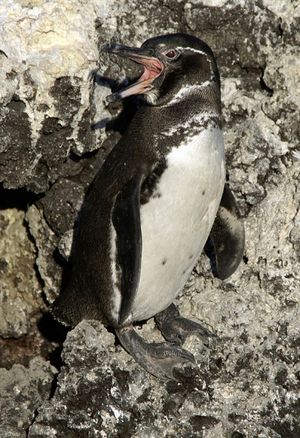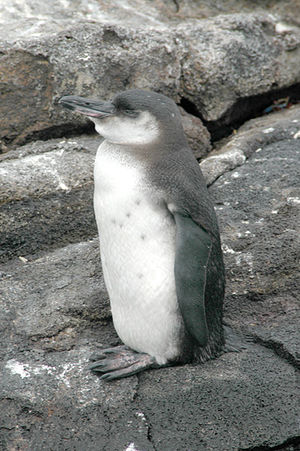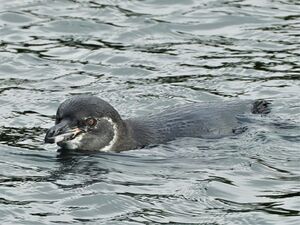Galapagos penguin

The Galápagos penguin (scientific name Spheniscus mendiculus) is one of seventeen species of flightless birds in the family Spheniscidae (the penguins). It is one of four "Banded Penguins" in the genus (Spheniscus), which also includes the Black-footed, Humboldt, and Magellanic penguins.
Like all penguins, the Galapagos penguin is characterized by its erect posture, stiff wings (modified into flippers), excellent swimming ability, awkward movement on land, and coloration. The black back and white front make penguins difficult to see when swimming, blending with the sea from above and with the sky from below.
|
Conservation Status |
|
Scientific Classification Kingdom: Animalia |
Contents
Physical Description
Galapagos penguins are the smallest members of the genus Spheniscus (banded penguins). The species is the third smallest penguin in the world, averaging only 48-53 cm in height and ranging in weight from 1.7 to 2.6 kg.
Like other banded penguins, adult Galapagos penguins are mainly black in color with white accenting colors on various locations of the body and a large white frontal area. As in all banded penguins, the head is black with a white mark that begins above both eyes and circles backwards, downwards, and forward to the throat. They have the narrowest head-stripe and least distinctive patterning within the genus. The Galapagos penguin has a small black throat collar. As with other members of the genus, there is a black horseshoe mark that starts on the breast and extends down the sides of the white undersides. Although the sexes are generally similar in appearance, sexual dimorphism exists, in that males average slightly larger than females. Juveniles have a totally dark head, and lack the dark breast bands seen in adults.
Reproduction
Most penguins have a distinct annual breeding season at a particular time of year, but the Galapagos penguin does not. Furthermore, it may produce as many as three clutches in a single year, although it is more usual that a pair will produce only one clutch, and possibly a second (often as a replacement) within a year. These adaptations help this species to cope with the highly unpredictable food resources reaching the Galapagos. The unpredictability of the ocean currents that bring small fish to the islands is compounded further by changes in water temperatures caused by El Nino events. The flexibility of breeding in this penguin allows it to take advantage of times of high food abundance. When the surface temperature of the sea becomes high, food shortages result as the water becomes very poor in nutrients. These periods are known as El Nino Southern Oscillations (ENSO). During these periods, the penguins will delay breeding completely until the food resources improve.
Pair bonds are for life, enabling these birds to begin breeding quickly when conditions improve. The bond is reinforced by mutual preening and bill tapping, or 'fencing'. Two eggs are produced at an interval of around four days. Incubation takes up to 40 days and is shared by the male and female. The chicks fledge after 65 days.
Breeding in Galapagos penguins involves a fairly complex set of courtship rituals before copulation occurs, both to attract a mate (if a new pair bond is being formed) and to strengthen the bond between the two partners. Such courtship rituals include displays of mutual preening, flipper patting, and bill fencing. Both male and female contribute to nest-building: the nest is created in an area shaded from the sun and protected from predators. When the complex courtship and initial nest building are complete, the penguins begin mating.
In Galapagos penguins, as in all other penguins, mating involves a balancing act in which the male climbs upon the back of the female who lies flat on the ground. Once on top, sometimes after several tries, the male and female copulate--the process usually only takes about one minute. As egg laying draws closer, the birds may copulate more frequently, mounting up to 14 times a day. Once the eggs are laid, both male and female will care for the young.
Galapagos penguins can breed more than once a year, producing two eggs per clutch, although only one young may be raised successfully. As the breeding season lasts year round, most breeding occurs whenever coastal waters are cold enough and abundant with prey (i.e. small fish). This occurs most often between May and July. However, as climatic changes are unpredictable, breeding can occur at any time of the year when conditions are favorable. Galapagos penguins construct nests in caves or volcanically-formed cavities before copulation takes place, these sites shading the eggs, incubating adults and growing chicks from the severity of the tropical sun. Incubation in Galapagos penguins lasts 38 to 42 days. Chicks fledge at approximately 60 days and are fully independent within 3 to 6 months. Female Galapagos penguins must wait another 3 to 4 years to reach sexual maturity while males must wait another 4 to 6 years. These birds will make their nests out of any resources that are available and often steal pebbles, sticks, and other components from a neighboring nest when the inhabitants are not present.
Parental investment of Galapagos penguins is divided between both males and females. Incubation duties are shared and, when one incubates, the other forages for food in coastal waters. Similarly, at hatching, one parent broods and guards the newly-hatched chick while the other forages for food to nourish itself and the chick. The foraging parent returns with food to regurgitate for the chick. This intense guarding and feeding process occurs for about 30 to 40 days, at which point the chick has grown substantially and can then be left alone for periods of time while the parents forage. This post-guarding period generally lasts less than one month, with the chick fledging at about 60 days.
Lifespan/Longevity
Galapagos penguins can live for 15 to 20 years. However, high mortality rates - due to predation, starvation, disease and climatic events mean that wild Galapagos penguins usually do not live to such ages.
Behavior
Galapagos penguins are social animals. This enables the birds to take advantage of group foraging and also provides them with some protection from predators. As with all penguins, these birds are awkward on land as a result of the position of their feet far back on the body, which forces them to take an upright position. When walking, Galapagos penguins waddle with outstretched wings. In contrast, these birds are superb swimmers.
The Galapagos penguin feeds on small fish in the coastal waters that surround their island homes. However, there is little information available on the behaviour of this species. On the limited amount of information we have, diving has been recorded between the hours of 05h30 and 18h30, with short breaks on land between dives. Most of these dives were shallow, recorded as deep as 32 m, although averaging around 2.5m, and take place close to the shore. However, it should be stressed that these observations relate to two birds only, and more research needs to be carried out before making generalised statements with regards to the diving capabilities and habits of this species. This species has a number of behavioral adaptations that allow these birds to keep cool on land. These include standing with the flippers extended to aid heat loss, as well as panting and seeking shade.
Galapagos penguins rely on a series of vocal calls and sounds as well as a complex array of body movements to communicate. Vocalizations are crucial in helping to identify mates and chicks. In courtship rituals, penguins rely heavily on displays and postures that advertise sexual status (paired or not paired), help to attract a mate, and reinforce the bond between the pair. Penguins also use vocalizations and body movements for general communication, such as greetings and displays of emotion.
Distribution and Home Range
Spheniscus mendiculus, as its English, French, Spanish & German vernacular names would suggest, is endemic to the Galápagos archipelago, officially owned by Ecuador, with 95% of the population occurring on the western islands of Fernandina and Isabela, and 5% on [[face="'Times New Roman','serif'">é]]], Santiago and Floreana. Galapagos penguins roam for food within the coastal waters of these islands, but specific home ranges are not reported. These birds live in small to large groups and are territorial during breeding, protecting their nesting area from their neighbors. Territory size depends on population density. This species has the smallest breeding range and lowest population numbers of all penguins, and is listed as 'endangered' by the IUCN. In 1999 the population numbered just 1,200 individuals.
Habitat
Galapagos penguins forage in the coastal waters during the day. These birds occupy coastal areas and offshore waters where the cold Cromwell Current brings food and other population-sustaining necessities into the vicinity. They rest on sandy beaches and rocky shores and nest on areas of sheltered coast.
Predation
Galapagos penguins lay their eggs in caves or holes in the volcanic rock, not only to avoid heat stress in a harsh environment, but also to reduce predation on their eggs. Nesting in a group, even if widely dispersed, enables these penguins to increase their vigilance against predators, and their alarm calls and posturing will alert others of the presence of a nearby predator. Predators on young penguins include crabs, snakes and (introduced) rats. As adults, Galapagos penguins are preyed on by hawks and owls, as well as feral cats and dogs. When foraging for food in the water, Galapagos penguins are preyed upon by sharks and other large, marine animals.
Food Habits
Galapagos penguins are carnivorous, eating many types of small fish (no longer than 15 mm in length) as well as small marine invertebrates of various kinds. Prey species include anchovies (Engraulidae), sardines and pilchards (Clupeidae), and mullets (Mugilidae). These birds use their flippers to swim through the water and use their small, stout beaks to capture their prey. They usually hunt in small, to occassionally large, groups.
Conservation Status
According to the IUCN Red List and the United States Endangered Species Act, Galapagos penguins are currently listed as endangered. Due to climatic variation brought about by El Niño and La Niña cycles, the food supply available to the Galapagos penguins varies greatly. These unpredictable shifts in food supply often lead to starvation and deaths and a substantial decline in the already dwindling penguin population. Furthermore, human disturbance and predation are major factors contributing to the decline of Galapagos penguins. In particular, human disturbance is damaging the nesting grounds of these, the most northerly of penguins. In the past, there has been little effort to protect the species. Recently, however, the Galapagos Conservation Trust launched the Sylvia Harcourt-Carrasco Bird Life Fund for the Galapagos, which will aim much of its efforts at conserving the population of Galapagos penguins. This fund provides a push for the conservation of the Galapagos penguin and which may lead to other conservation actions, and, hopefully, eventually to a restored, healthy population. The total range of the Galapagos penguin is contained within the Galapagos National Park and Marine Reserve.
At present, all populations are closely monitored and feral animals are controlled. Proposed measures to assist this highly endangered species include discouraging the use of fishing nets in the foraging area, preventing coastal developments in the breeding areas, and providing nest-boxes in predator free areas to allow research into the reproductive success of the species. As the population of the diminutive and uniquely adapted Galapagos penguin is so small and precarious, the species is extremely vulnerable to extinction.
Threats
The main threat facing this penguin is the fluctuation in food supply, compounded by El Niño and La Niña events. The 1982-1983 'El Niño' Southern Oscillation (ENSO) resulted in the catastrophic loss of 77% of the population through starvation. A slow period of recovery followed, but the 1997-1998 ENSO resulted in another precipitous population crash of about 66%. It is now thought that the species is experiencing another recovery phase. Other threats facing this beleaguered penguin include predation by introduced feral animals such as domestic dogs and cats, increased disturbance by tourists, water pollution, and fishing.
Economic Importance for Humans
Galapagos penguins provide economic value to humans who use this species and its coastal habitat to promote eco-tourism. Many tourists will pay to travel and visit the habitats of this species.
Galapagos penguins may cause minor economic harm to the seafood industry for humans. As S. mendiculus relies heavily on a diet of small fish, such as anchovies and sardines, collectively the species may have an effect on the number of small fish available for human consumption in their range. It has been shown that a penguin population can eat upwards of 6,000 to 7,000 tons of food locally, approximately 3,000 tons of that total has some economic value to humans.
References
- Spheniscus mendiculus Sundevall 1871 Encyclopedia of Life (accessed March 11, 2009)
- Species 2000 & ITIS Catalogue of Life: 2009 Annual Checklist. Bisby FA, Roskov YR, Orrell TM, Nicolson D, Paglinawan LE, Bailly N, Kirk PM, Bourgoin T, Baillargeon G., eds (2009), Species 2000: Reading, UK.
- Spheniscus mendiculus, Myers, P., R. Espinosa, C. S. Parr, T. Jones, G. S. Hammond, and T. A. Dewey, The Animal Diversity Web (online), 2008 (accessed March 16, 2009)
- WoRMS, World Registry of Marine Species
- IUCN Red List (September, 2007)
- BirdLife International (April, 2003)
- Global Register of Migratory Species (March, 2008)
- International Penguin Conservation (April, 2003)


